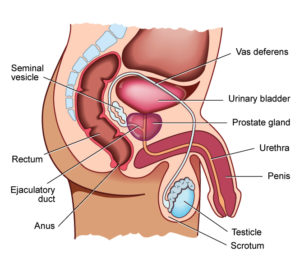
13 Sep Men’s Health and the Prostate….what you need to know!
Men’s Health and the Prostate….what you need to know!
Slow or weak stream? Difficulty getting the flow started or a sensation of incomplete bladder emptying? Sleep disrupted due to frequent night toilet visits? Pain during or after weeing? These are all signs of bladder dysfunction, and for men, the culprit may well be the prostate.
The prostate is a small walnut sized gland which produces fluids that protect and feed sperm cells. It sits below the bladder, around the urethra (the tube from your bladder) and near the rectum.
There are 3 main issues that may arise within the prostate over a man’s lifetime. These include prostatitis (inflammation of the prostate), Benign Prostatic Hyperplasia (enlargement of the prostate) and Prostate Cancer.
Prostate cancer is the most commonly diagnosed cancer in men in Australia. Each year 20,000 men are diagnosed with prostate cancer. Not all men diagnosed with prostate cancer experience symptoms prior to diagnosis and therefore it is important that all men are checked starting at 50, or as early as 40 if they are high risk.
A common treatment for prostate cancer is a prostatectomy, or removal of the prostate. The most common side effects of surgery include bladder incontinence and erectile dysfunction, which occur as a result of structural changes to bladder supports and the nerves impacted by removal of the prostate.
Pelvic Floor Physiotherapy is an important part in the preparation for, and recovery after prostate removal. Whilst most men are not aware of their existence, men too have pelvic floor muscles, and they play a significant role in the recovery of bladder control following prostate surgery. Men are seen prior to their surgery to learn how and when to activate their pelvic floor muscles, and for education regarding optimisation of recovery following surgery.
Enlargement or growth of the prostate with age is common; however the precise reason for this growth is unknown. Enlargement can, and often does occur in the absence of prostate cancer, however if you have any signs of voiding dysfunction it is recommended that you consult your GP. As the prostate grows larger it squeezes tighter around the urethra. This can result in more difficulty emptying the bladder, with more obvious symptoms for some men than others. Common signs of an enlarged prostate include:
- Difficulty starting urinary flow.
- A weak, slow or stop/start stream.
- A feeling of incomplete bladder emptying and/or a need to return to the toilet soon after your last void.
- Dribbling urine, especially after voiding.
- An increased frequency of urination, often accompanied by a sudden strong desire to void.
- Increased night toilet visits.
- Blood in the urine.
Treatment of an enlarged prostate can include conservative strategies, medication and in some cases surgery. A pelvic floor physiotherapist can assist in improving your bladder function through a range of strategies including fluid modification, relaxed voiding techniques and ensuring good bowel health.
